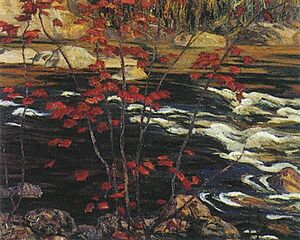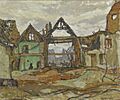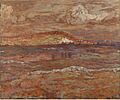A. Y. Jackson facts for kids
Quick facts for kids
A. Y. Jackson
|
|
|---|---|
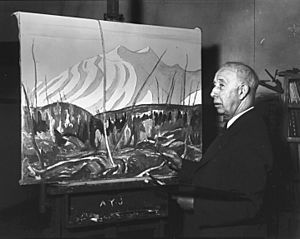
Jackson at work in the Studio Building, Toronto, 1944
|
|
| Born |
Alexander Young Jackson
October 3, 1882 Montreal, Quebec, Canada
|
| Died | April 5, 1974 (aged 91) Kleinburg, Ontario, Canada
|
| Education | Monument-National, Art Institute of Chicago, Académie Julian |
| Known for | Painter |
| Movement | Group of Seven |
Alexander Young Jackson (October 3, 1882 – April 5, 1974) was a very important Canadian painter. He was one of the founding members of the famous Group of Seven. Jackson helped shape Canadian art and brought together artists from Montreal and Toronto.
Besides his work with the Group of Seven, he was also a war artist during World War I (1917–1919). He taught art at the Banff School of Fine Arts from 1943 to 1949. Later in his life, he was an artist who lived and worked at the McMichael Canadian Art Collection in Kleinburg, Ontario.
Contents
Early Life and Art Training
Jackson was born in Montreal. When he was a young boy, his father left the family, and Jackson had to start working. He got a job as an office boy at a company that made lithographs (a type of printing). This is where he first started learning about art.
In the evenings, he took art classes at the Art Association of Montreal in 1902. In 1905, Jackson traveled to Europe on a cattle boat to save money. He returned the same way and went to Chicago. There, he worked for an art company and took classes at the Chicago Art Institute.
By 1907, he had saved enough money to visit France. He wanted to study Impressionism, a style of painting. In France, Jackson decided to become a full-time painter. He studied at the Académie Julian in Paris. He also spent time at the Étaples art colony in France, where he painted Paysage Embrumé. This painting was even accepted by the famous Paris Salon art show.
Becoming a Professional Artist
When Jackson came back to Canada, he lived in Sweetsburg, Quebec. He started painting works like Edge of the Maple Wood. In 1913, he had his first art show in Montreal. He was finding it hard to make enough money from his art and thought about moving to the United States.
But then, he got a letter from J. E. H. MacDonald. MacDonald had seen Edge of the Maple Wood at a show in Toronto. He told Jackson that another Toronto artist, Lawren Harris, wanted to buy it. After this, Jackson started writing to MacDonald and Harris. They often talked about Canadian art.
Soon, Jackson began visiting Toronto. A doctor named James MacCallum offered to buy enough of Jackson's paintings for a year. This meant Jackson would have enough money to live. So, Jackson moved to Toronto and into the Studio Building. This building was paid for by Lawren Harris and Dr. MacCallum.
Jackson was a great addition to the Toronto art scene. He had traveled in Europe and brought new ideas. His painting Terre Sauvage became one of his most famous works. In 1914, Tom Thomson also moved into the Studio Building and shared a studio with Jackson for a year.
Like the other painters who would form the Group of Seven, Jackson loved painting landscapes. He wanted to create a strong, new style of Canadian art. Jackson was an outdoorsman and became good friends with Tom Thomson. They often went fishing and sketching together, especially in Algonquin Park. Inspired by Thomson, Jackson and the others explored places like Algonquin Park, Georgian Bay, and the North Shore.
War Artist
When World War I started, Jackson joined the Canadian Army in 1915. He was wounded in 1916 and ended up in a hospital in France. While he was getting better, he was asked to become a war artist.
From 1917 to 1919, Jackson worked for the Canadian War Memorials. He created 45 artworks showing scenes from the war. These included powerful paintings like A Copse, Evening (1918), which showed the impact of the war on the land in Belgium. Many of his war paintings are now in the Canadian War Museum in Ottawa.
Forming the Group of Seven
After the war, Jackson moved back into the Studio Building. He used Tom Thomson's easel for all his future paintings there. Soon after, he found out he was part of a new group of artists. This group, called the Group of Seven, had their first exhibition.
In 1919, Jackson and six other painters officially formed the Group of Seven. These artists were seen as brave because, before them, many thought the rugged Canadian northern landscape was too wild to paint. The Group of Seven wanted to show the unique beauty of Canada's wilderness. Many of Jackson's paintings started as small oil sketches done outdoors, known as "en plein air."
Jackson also helped form the Beaver Hall Group in Montreal in 1920. He believed artists should paint what they feel, without worrying about old rules. He kept in touch with the Montreal artists, visiting them and helping their work be shown in Group of Seven exhibitions. He made lifelong friends with artists like Anne Savage and Kathleen Morris.
Jackson loved painting landscapes from his home province of Quebec. He often painted old farmhouses, barns, and trees. He also loved painting snow, watching how the sun and wind changed its colours and textures.
In 1932, Jackson painted the Falconbridge smelter near Sudbury, in a painting called Smoke Fantasy. He also worked to protect nature. He wrote to the government to save land that became Killarney Provincial Park. A lake was even named after him on his 90th birthday.
In 1938, Jackson visited a remote Radium mine in the Northwest Territories. He was friends with the mine manager and flew there to paint Radium Mine. During World War II, Jackson helped create the Canadian War Art Program in 1943. He also helped organize a large public art project called the Sampson-Matthews silkscreen print program.
In 1955, Jackson moved out of the Studio Building. Lawren Harris wrote to him, saying that Jackson leaving marked the end of an important time for Canadian art. Harris said Jackson was the "real force and inspiration" for a new Canadian art style.
Group of Seven
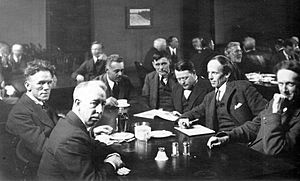
The Group of Seven artists were considered bold. This was because the Canadian northern landscape had not been painted much before. They believed this rugged and wild land was beautiful and deserved to be shown in art. Like other members of the Group of Seven, many of Jackson's works started as small oil sketches done outdoors.
In 1925, Jackson taught at the Ontario College of Art in Toronto. This was the only year he missed his yearly spring trip to Quebec. In 1933, Jackson, along with Harris, helped start the Canadian Group of Painters. Several members of the Group of Seven also joined this new group.
Later Years
In 1943, Jackson first traveled to the Yukon. He went back in 1964 with other artists, flying over the landscape. In 1954, he was one of 18 Canadian artists asked by the Canadian Pacific Railway to paint a mural for their new transcontinental train. Jackson's mural showed Kokanee Glacier Provincial Park.
In 1953, a big art show called A. Y. Jackson: Paintings 1901–1953 was held to celebrate his work. Jackson moved to the Ottawa area in 1955. He often went on painting trips with friends and fellow artists. One time, a bullet even ricocheted off a rock near where he was sitting!
In 1958, he wrote his autobiography, A Painter's Country. It was dedicated to J. E. H. MacDonald, who dreamed of a Canadian style of painting. In 1965, Jackson had a serious stroke, which meant he could no longer paint. He moved to the McMichael Conservation Estate in Kleinburg, Ontario.
Jackson passed away in 1974. He is buried on the grounds of the McMichael Canadian Art Collection.
Honours
- In 1941, Queen's University gave Jackson an honorary degree (LL.D.).
- In 1946, he was made a Companion of the Order of St Michael and St George.
- In 1962, the University of Saskatchewan also gave him an honorary degree.
- In 1967, Jackson was made a Companion of the Order of Canada, a very high honour.
- Two high schools are named after him: A. Y. Jackson Secondary School in Toronto and A. Y. Jackson Secondary School in Ottawa.
- In 1970, the Royal Canadian Academy gave Jackson a medal for his lifetime of artistic achievement.
- The A. Y. Jackson Lookout on Highway 144 in Sudbury overlooks a waterfall he painted.
- The Ottawa River Institute has created an A. Y. Jackson Trail in his honour.
Quotes from A. Y. Jackson
About painting in Algoma, he wrote:
Sketching here demanded a quick decision in composition, an ignoring or summarizing of much of the detail, a searching‒out of significant form, and a colour analysis that must never err on the side of timidity. One must know the north country intimately to appreciate the great variety of its forms. The impression of monotony that one receives from a train is soon dissipated when one gets into the bush. To fall into a formula for interpreting it is hardly possible.
Images for kids
-
Cathedral at Ypres, Belgium, 1917, McMichael Canadian Art Collection, Kleinburg, Ontario
-
House of Ypres, 1917–18, Canadian War Museum, Ottawa, Ontario
See Also
- Canadian official war artists
- War art
- The Studio Building, Toronto, the home and working studio of several Group of Seven painters
 In Spanish: A. Y. Jackson para niños
In Spanish: A. Y. Jackson para niños


